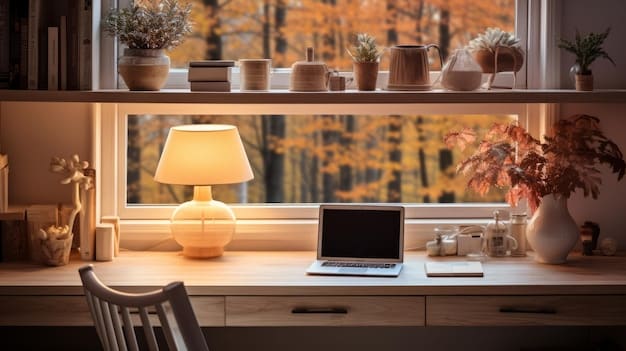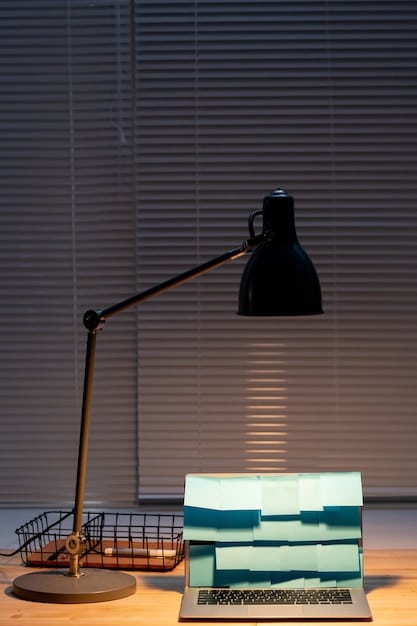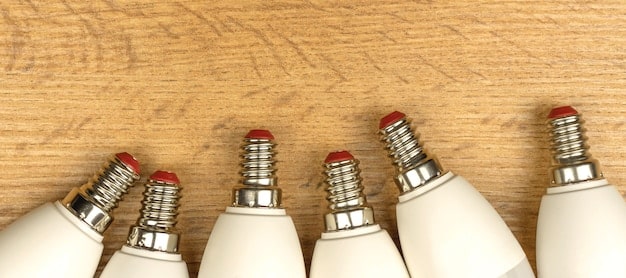Optimize Your Home Office Lighting: Boost Focus & Reduce Strain

Optimizing your home office lighting involves strategically implementing natural and artificial light sources to minimize eye strain, enhance focus, and boost overall productivity for a more comfortable and efficient workspace.
Working from home offers flexibility, but it also presents challenges, especially when it comes to creating a productive workspace. Optimizing your home office lighting: Enhancing focus and reducing eye strain is crucial, as inadequate lighting can lead to fatigue, headaches, and decreased concentration.
Why is home office lighting important?
Adequate lighting is more than just a matter of aesthetics; it directly impacts your health and productivity. When your workspace is poorly lit, your eyes have to work harder to focus, leading to eye strain and fatigue. This can also trigger headaches and make it difficult to concentrate, ultimately reducing your efficiency.
The impact on your eyes
Prolonged exposure to inadequate lighting can cause significant eye strain. Symptoms include dry eyes, blurred vision, and headaches. By improving your lighting, you reduce the strain on your eyes, making it easier to work comfortably for extended periods.
Boosting productivity
Proper lighting can significantly boost your productivity. A well-lit workspace promotes alertness and focus, helping you stay on task and accomplish more. By optimizing your lighting, you create an environment that supports concentration and efficiency.
- Reduce eye strain and fatigue.
- Improve focus and concentration.
- Enhance overall productivity.
- Create a more comfortable workspace.
In conclusion, prioritizing home office lighting is a worthwhile investment in your health and productivity. By addressing the issues of eye strain and focus, you’ll create a workspace that supports your well-being and enhances your efficiency.

Understanding different types of lighting
Different types of lighting have different effects on your mood, energy levels, and overall productivity. The key to optimizing your home office lighting: Enhancing focus and reducing eye strain is to understand the characteristics of each type and how they can be strategically used to create a comfortable and efficient workspace.
Natural light
Natural light is often considered the best option for your home office. It’s free, abundant, and provides a full spectrum of light that’s easy on the eyes. Position your desk near a window to maximize natural light exposure.
Artificial light
When natural light isn’t sufficient – especially during evenings or overcast days – artificial light becomes essential. There are several options to choose from, each with its own strengths and weaknesses. Consider the color temperature and brightness levels to ensure they complement your natural light.
Types of artificial light
Options to consider are incandescent, fluorescent, and LED. Incandescent lights tend to be warm and inviting, while fluorescent lights are energy-efficient and can provide a cooler, more focused light. LEDs are highly versatile, efficient, and available in a wide range of color temperatures.
- Maximize natural light exposure by positioning your desk near a window.
- Use artificial light to supplement natural light, especially during evenings or overcast days.
- Consider the color temperature of artificial light to create a specific mood or focus.
In conclusion, understanding the different types of lighting available and how they impact your workspace is essential for creating an environment that supports both your well-being and your productivity. By carefully selecting and positioning your light sources, you can optimize your home office for maximum comfort and efficiency.
Choosing the right light bulbs
Selecting the right light bulbs for your home office can make a significant difference in your comfort and productivity. It’s essential to consider not just the brightness, but also the color temperature and energy efficiency of the bulbs you choose.
Color temperature
Color temperature is measured in Kelvin (K) and affects the mood and ambiance of your workspace. Warmer temperatures (2700K-3000K) emit a soft, yellow light that’s relaxing, while cooler temperatures (4000K-6500K) emit a bright, white light that’s energizing and conducive to focus.
Brightness
Brightness is measured in lumens. The appropriate brightness level depends on the size of your office and the tasks you perform. For general lighting, 400-800 lumens is usually sufficient. Task lighting, such as a desk lamp, may require brighter bulbs with 800-1600 lumens.
Energy efficiency
Energy-efficient light bulbs, like LEDs, not only reduce your electricity bill but also last longer than traditional incandescent bulbs. LEDs are also more environmentally friendly, as they consume less energy and don’t contain harmful substances like mercury.

Choose LED bulbs with a color temperature of 4000K-5000K for optimal focus and productivity. These provide a bright, natural-feeling light that minimizes eye strain. Additionally, consider the energy efficiency to save on electricity bills and reduce environmental impact.
- Consider color temperature to set the right mood and ambiance for your workspace.
- Select bulbs with appropriate brightness levels for general and task lighting.
- Prioritize energy-efficient options, such as LEDs, to save energy and reduce environmental impact.
In conclusion, carefully selecting light bulbs based on color temperature, brightness, and energy efficiency is a key step in optimizing your home office lighting: Enhancing focus and reducing eye strain By making informed decisions, you’ll create a comfortable and productive workspace that supports your well-being.
Arranging your lighting effectively
Effectively arranging your lighting ensures that your workspace is properly illuminated and free from glare. Consider the placement of each light source and how it interacts with the natural light in your office.
Layering light sources
Layering involves combining different types of lighting to create a balanced and comfortable environment. General lighting provides overall illumination, while task lighting provides focused light for specific tasks. Accent lighting can be used to highlight certain areas or objects.
Avoiding glare
Glare occurs when light reflects off surfaces and enters your eyes, causing discomfort and eye strain. Position your light sources carefully to avoid glare on your computer screen or other work surfaces. Use lamps with adjustable heads to direct the light where it’s needed.
Optimal placement
Place your desk lamp on the opposite side of your writing hand to prevent shadows. Angle the light downward to illuminate your workspace without causing glare. Consider adding uplights to bounce light off the ceiling and create a softer, more diffused illumination.
By layering light sources, you can achieve a balanced and comfortable workspace. Position your desk lamp to avoid shadows, and use adjustable heads to direct light where it’s needed. Pay attention to reflections to minimize glare on your screen or work surfaces.
- Layer different types of lighting to create a balanced environment.
- Position light sources carefully to avoid glare on your computer screen or work surfaces.
- Use lamps with adjustable heads to direct light where it’s needed.
In conclusion, arranging your lighting effectively involves careful consideration of light source placement, glare prevention, and layering techniques. By optimizing the arrangement of your lights, you’ll create a workspace that is both comfortable and conducive to productivity, minimizing eye strain and maximizing focus.
Adjusting lighting for different tasks
Lighting requirements can vary significantly depending on the task at hand. Adjusting your home office lighting: Enhancing focus and reducing eye strain for specific activities ensures that you have the right amount of light in the right places.
Reading
When reading, focus and direct light on the reading material to prevent eye strain.
Computer work
When working on a computer, proper light will help reduce reflections and eye strain.
Writing
Bright and focused lighting is essential for writing, whether you’re using pen and paper or typing on a keyboard. Use a desk lamp to illuminate your workspace and minimize shadows. Check for glare and adjust your lighting as needed to maintain optimal visibility.
Adjust the brightness and color temperature of your lights to match the task at hand. Increase brightness for tasks that require detailed vision, like writing or reading small print. Use cooler color temperatures (4000K-5000K) to promote alertness and focus during computer work.
- Adjust brightness levels based on the task, increasing them for detail-oriented activities.
- Change color temperatures to promote alertness or relaxation as needed.
- Use task lighting to focus light on specific work areas.
In conclusion, adjusting your lighting for different tasks is a simple yet effective way to enhance your productivity and reduce eye strain. By tailoring your lighting to the specific demands of each activity, you’ll create a workspace that supports your focus and well-being.
Maintaining your lighting setup
Regular maintenance of your lighting setup ensures that it continues to function optimally. This includes cleaning fixtures, replacing bulbs, and making necessary adjustments. A well-maintained lighting system provides consistent and reliable illumination, reducing eye strain and enhancing productivity.
Cleaning fixtures
Dust and grime accumulate on light fixtures over time, reducing their brightness and efficiency. Clean your fixtures regularly with a soft cloth to maintain optimal light output. Turn off the power before cleaning to avoid electric shock.
Replacing bulbs
Light bulbs gradually lose brightness over time, even before they burn out. Replace bulbs regularly to maintain consistent illumination levels. Consider replacing all the bulbs in your office at the same time to ensure a uniform appearance.
Adjusting placement
As your needs change, you may need to adjust the placement of your light sources. Experiment with different positions to find the optimal arrangement for your current tasks. Monitor glare and shadows, and make adjustments as needed to maintain a comfortable and productive workspace.
Regularly clean your light fixtures and replace bulbs to maintain brightness. Adjust the placement of your lights as needed to optimize illumination and minimize glare. By keeping your lighting system in top condition, you’ll ensure a consistent and comfortable workspace.
- Clean light fixtures regularly to remove dust and grime.
- Replace bulbs to maintain optimal brightness levels.
- Adjust the placement of light sources as needed to minimize glare and shadows.
In conclusion, maintaining your lighting setup is crucial for ensuring long-term comfort and productivity in your home office. By investing a small amount of time and effort in regular maintenance, you’ll keep your lighting system functioning optimally, reducing eye strain and promoting focus for years to come.
| Key Point | Brief Description |
|---|---|
| 💡Natural Light | Maximize natural light; position your desk near a window. |
| 🔆Artificial Light | Supplement with LED; choose 4000K-5000K for optimal focus. |
| 🚫Avoid Glare | Position lights carefully; use adjustable lamps to direct light. |
| 🛠️Maintenance | Clean fixtures, replace bulbs, and adjust as needed. |
Frequently Asked Questions
▼
Natural light is generally considered the best for a home office, supplemented by LED artificial light with a color temperature of 4000K-5000K to enhance focus. Aim to optimize your home office lighting: Enhancing focus and reducing eye strain .
▼
Avoid glare by positioning your monitor away from direct light sources. Use an antiglare screen and follow the 20-20-20 rule: every 20 minutes, look at something 20 feet away for 20 seconds. This will optimize optimizing your home office lighting: Enhancing focus and reducing eye strain.
▼
For a home office desk lamp, aim for 400-800 lumens for general lighting and 800-1600 lumens for task lighting. Adjust based on the size of your room and preferences while optimizing your home office lighting: Enhancing focus and reducing eye strain.
▼
Cool light (4000K-5000K) is generally better for focus and productivity because it mimics daylight. Warmer light can be more relaxing, but may cause drowsiness. Properly optimizing optimizing your home office lighting: Enhancing focus and reducing eye strain will solve this issue.
▼
Replace your light bulbs when they start to dim or flicker. LED bulbs can last for several years, but it’s essential to monitor their performance to maintain optimal lighting optimizing your home office lighting: Enhancing focus and reducing eye strain.
Conclusion
Creating an optimal lighting environment in your home office is critical for productivity, comfort, and eye health. By understanding the principles of natural and artificial light, choosing the right bulbs, and arranging your lighting effectively, you can create a workspace that supports your focus and well-being. Consistent attention to maintaining your lighting setup will ensure long-term benefits, contributing to a more enjoyable and productive remote work experience.





